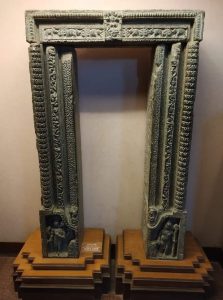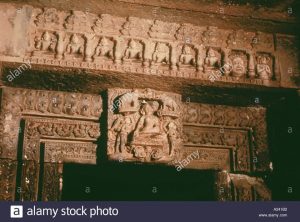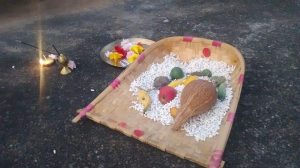|
By: Saswat Routray Sharad Purnima is the first full moon of the Ashwina Month of Hindu calendar. It is called Sharad Purnima because it marks the end of autumn. Sharad ritu signifies the transition period between autumn and winter. It is also known as Ashwina Purnima and marks the end of Ashwina month. Sharad Purnima is the harvest festival, marking the harvest of the crops grown. Hence, it is also called Nabanna/Navanna (new rice) Purnima. On this day, moon is the closest to our Earth. That is why it is believed that moonlight has healing effect on this night. Food kept in moonlight on this night is considered as elixir.   As per Odia belief, this day is known as the birthday of Goddess Lakshmi- signifying the philosophy that Lakshmi is associated with wealth & crops and new crops. New crops are harvested & taken inside the house on this day.Once, Debraj Indra lost his wealth, property, grandeur and fortune. On this day, Lakshmi churned the ocean and emerged from it along with elephants. She had brought Indra’s lost wealth and restored his fortune. Lakshmi’s association with elephants is one of the eight forms of Maa Lakshmi and earned her the name “Gajalakshmi”. She is the Goddess of elephants- bringer of wealth, cattle, crops, power, strength, grace, prosperity & fertility.   States like Odisha, Maharastra, Goa, etc worship the Gajalakshmi form and hence, the custom is known as Gajalakshmi Puja in these states. In fact, the Gajalakshmi form had been very popular in Kalinga architecture. Often, the Gajalakshmi motifs are found on temple doors, pillars, lalat-bimba, etc. This is also due to the fact that Kalinga always had deep rooted association with everything associated with elephants. The kings were called Gajapatis and historical records say 99,000 war elephants were incorporated by the Gajapatis in their army. Even the Jalabhishek of Jagannath Deva during Chodaganga Deva’s time was carried out by 99,000 elephants, who would bring water in their tusk. Historical notes also say that during the reign of Jajati Keshari in 10th Century CE, elephants were worshiped along with Gajalakshmi during the Puja. The remnants of this tradition can still be seen in Dhenkanal today, where Pandals and Mandaps of Gajalakshmi Puja throng with massive effigies of Gajas of Kalinga.
 The biggest Gajalakshmi Puja takes place in Dhenkanal region of Odisha. Here, Gajalakshmi is worshipped for 11 days starting from the full moon. Also, the entire town teems up with diyas and lamps just like Diwali on the eve of Gajalakshmi Puja. Pandals, puja mandaps, decorations, etc all have a striking feature marking the unique tradition of the region.Sharad Purnima is popularly known as Kumar Purnima in Odisha. That is because both the unmarried girls and boys pray to God to have suitable spouse in their life. ● They wake up early in the morning before sunrise, bathe and get dressed to perform “Janhi Osha”– a ritual in which Sun God is offered palmful of “khai” with striped gourd (Janhi in Odia), cucumber, banana, coconut, gua (betel nut), etc. They lighten a lamp to pray to Sun God for a suitable spouse.  ● Lord Kartika, who is also known as the God of War, was born on this day. Unmarried devout Odia girls, who perform puja in Kumar Purnima, pray to God for eligible, suitable, courageous & handsome bachelor like Lord Kartika for marriage. Since Lord Kartika is forever bachelor (kumar), hence the name Kumar Purnima has another significance, too. However, devout Odia girls who desire husband like Shiva, take part in Shivratri rather than Kumar Purnima.  ● The full moon is the centre of attraction in this festival. When the night falls, unmarried boys and girls pray to Moon God for suitable spouses. The moon is also synonymous to a handsome husband that the girls are seeking for themselves. Old grannies are of the opinion that a girl has to see the ‘Udita Janha’ (the fresh moon that has just risen on the horizon) for a young and attractive husband; if one takes too long to see the just-risen moon, then an old and senile bridegroom is in their destiny. Girls and boys offer Chanda Chakata to Moon God. Chanda Chakata is a dessert made up of khai, jaggery, banana, coconut, ginger, sugarcane, cucumber, ghee, honey, milk, tala khukundi, tala gaja and talasaja (tala in Odia, Palmyra in English) by laying it off on a “kula” (winnowing fan). The dessert is prepared in shape of half moon.  ● Note the philosophy of worshiping Moon God on the night when it is closest to the Earth. Alpana or Jhoti with lily petals, rice paste (chaula gunda pani) are decorated along the place of worship and throughout the households, especially Tulasi Chaunra (Tulsi Manch). One striking feature of the festival is that most of the decorations are done with white colored petals, rice paste, etc because moon in white in color. Starting from Bhadrava Purnima, girls gather at the Tulasi Chaunra (Tulsi Manch) every evening and decorate it with janhi (ridge gourd) flowers that bloom during this time.  ● A sport called “Puchi” is the signature of Kumar Purnima festival in Odisha. Even the schools organize such event for girls. The game is played in squatting position shifting and balancing the weight from one leg to another. The sport is played with local folk songs.  The day after Sharad Purnima, Kumar Purnima, Gajalakshmi Puja marks the starting of auspicious Kartik Month of the Hindu calendar. The first day of the Kartika is also called Kartika Bratarambha (Brata/Vrat Arambha). During the Kartika Month the entire Hindu population of Odisha becomes strictly vegetarian. They observe the month with auspicious customs, continuing till the traditional ceremony of Panchuka which falls on last five days of the month. The Kartika Month ends on Kartika Purnima. The day after Kartika Purnima is called Chhada Khai when the non-vegetarian people can again start their normal diet. By the way, the most fascinating part of Kartika Purnima in Odisha is the celebration of historic Boita Bandana to commemorate the Bali-Jatra commenced by ancient Kalinga merchants and associated fleet to do trade in far South East Asia like Bali, Indonesia, etc.Thanks to Saptashree Tripathy & Prajna Priyadarshini for special inputs. |
|